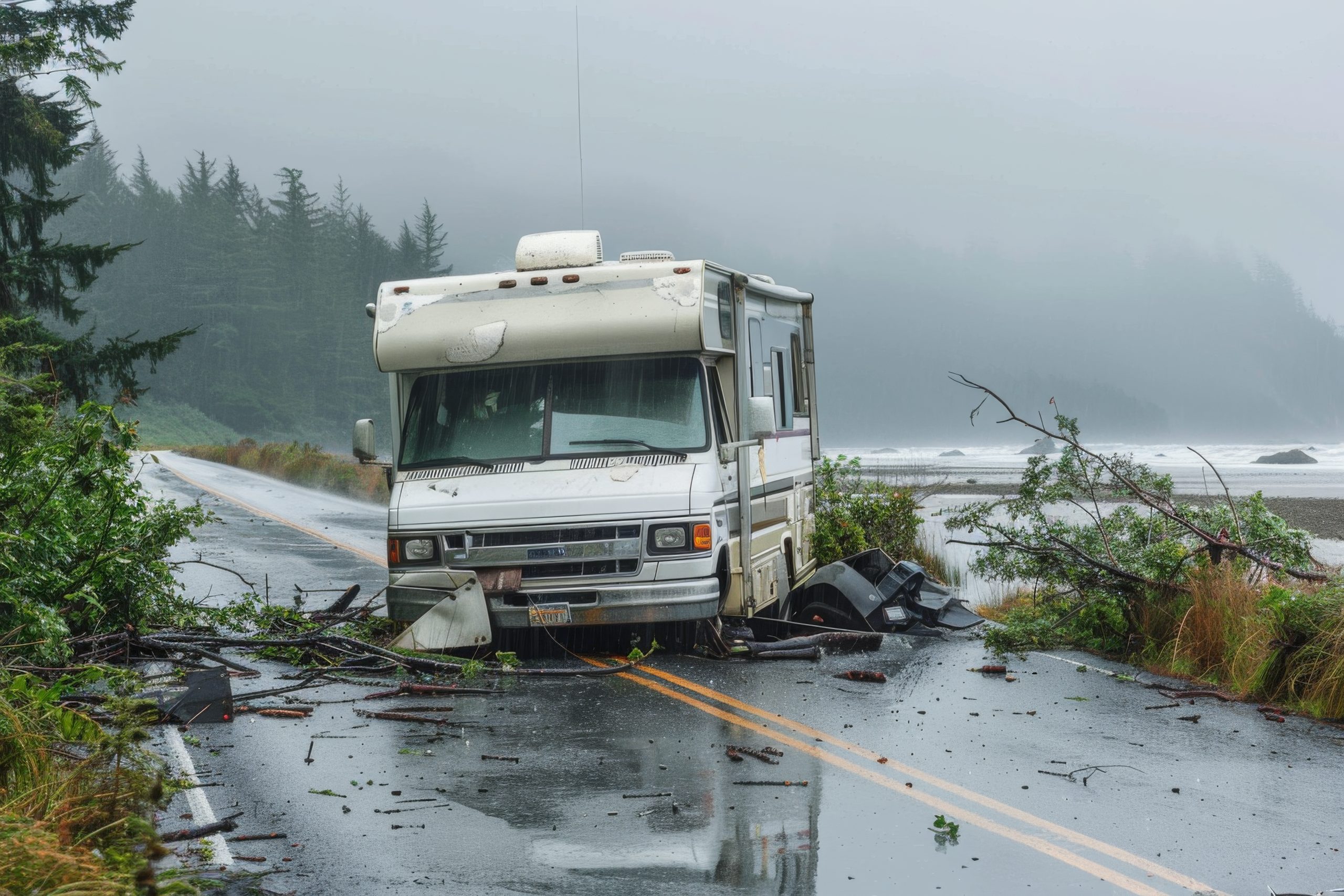RV undercarriage damage encompasses any harm affecting the bottom portion of your recreational vehicle—specifically the components directly exposed to the road surface—including your exhaust system, suspension mechanisms, holding tanks, and propane systems. Protecting these vital components with proper coverage is why comparing RV insurance quotes from reputable RV insurance companies is essential for any recreational vehicle owner.
When examining your RV for potential issues, most owners focus on visible exterior damage and engine performance problems. If you scratch your side panel on a tree branch, accidentally back into a campsite post, or notice smoke coming from your engine compartment, you immediately know where to investigate.
But what about that time you navigated a rugged campground road or drove through an uneven national park entrance? While damage beneath your RV isn’t easily visible, undercarriage issues are crucial to monitor for maintaining your recreational vehicle’s optimal condition and safety.
Identifying undercarriage damage on an RV can be challenging, which is why Happy Camper has created this comprehensive guide covering everything you need to know. We’ll explore what comprises your RV’s undercarriage, common causes of damage, and warning signs that indicate potential problems requiring attention.
What Constitutes an RV’s Undercarriage?
The undercarriage of a recreational vehicle refers to the network of components beneath the main living cabin that directly face the road surface. Major elements located in an RV’s undercarriage include the exhaust system, suspension components, fresh/gray/black water tanks, propane lines, stabilizing jacks, and frame supports.
An RV’s undercarriage is designed to protect the lower mechanical systems, so these components are constructed with durability in mind to withstand continuous exposure to roadways and environmental elements. However, they aren’t indestructible, which makes monitoring for undercarriage damage essential for long-term RV maintenance.
What Does Undercarriage Damage Mean for RV Owners?
Undercarriage damage describes any harm inflicted on the bottom section of your recreational vehicle. Since this area constantly faces the road, it experiences ongoing wear from debris, varying road conditions, and weather exposure throughout your travels.
Common Causes of RV Undercarriage Damage
Your recreational vehicle’s undercarriage can sustain damage through several means. Here are the most frequent causes of RV undercarriage damage:
Mud Accumulation: If you regularly take your RV to remote campgrounds, travel on unpaved roads, or camp in rainy locations, mud kicked up from your wheels can collect in your undercarriage and cause problems. Mud retains moisture, so accumulated buildup can promote rust development on critical undercarriage components.
Road Salt Exposure: Salt-related undercarriage damage is particularly common in colder regions where road salt is applied to melt ice and improve driving safety. Prolonged contact with salt can corrode undercarriage parts, compromising important RV components and making them vulnerable to additional damage.
Uneven Terrain: Driving over rough campground roads, large rocks, or unexpected dips at high speeds can significantly damage your RV’s undercarriage. The impact may cause your recreational vehicle to strike the ground surface, potentially resulting in fluid leaks, exhaust system damage, suspension issues, or structural cracks. RV owners often refer to this as “bottoming out.”
How to Recognize RV Undercarriage Damage
While crawling beneath your recreational vehicle to inspect for visible damage can be difficult (and sometimes hazardous), certain indicators may suggest your RV’s undercarriage has sustained damage. Here are the most common signs of undercarriage problems:
Fluid Leakage: If you notice pools of liquid beneath your parked RV or inside the wheel areas, this could indicate undercarriage damage. Pay particular attention to different fluid colors – brown/black (oil), red (transmission fluid), green (coolant), or clear (water from tanks).
Strong Petroleum Odor: Detecting engine oil smells inside or around your RV might signal that part of your vehicle’s undercarriage, such as an oil pan or transmission line, has cracked and requires repair. This is especially concerning when parking overnight at campsites.
Handling Difficulties: If you notice your RV pulling toward one side while driving or find the steering less responsive, this could indicate undercarriage damage affecting control arms, steering mechanisms, or suspension components that need professional assessment.
Visual Damage or Hanging Components: Visible scrapes around your RV’s lower edges or components hanging below the normal line while parked likely indicate collision with road obstacles that have damaged your undercarriage.
If you suspect your recreational vehicle has undercarriage damage, schedule an inspection with an RV service center promptly. Maintaining your undercarriage is just as vital as regular RV maintenance for safe travels. When shopping for coverage, always ensure the RV insurance companies you’re considering offer specific protection for undercarriage components, as some basic policies might exclude these critical areas.
Protecting Your RV Investment with Proper Insurance
Significant undercarriage damage could present you with an unexpected repair bill that disrupts your travel budget. However, with comprehensive RV insurance coverage, you can protect yourself from these surprise expenses while ensuring your home-on-wheels receives proper repairs. Before settling on a policy, request an RV insurance quote from multiple RV insurance companies to compare coverage options specifically for undercarriage protection, as this often-overlooked area can lead to costly repairs if improperly insured.
Safeguarding Your RV Adventures: Get a RV Insurance Quote!
Unexpected undercarriage damage shouldn’t mean the end of your travel plans or a devastating financial setback. At Happy Camper, we stand out among RV insurance companies by truly understanding the unique needs of recreational vehicle owners and offering specialized insurance solutions designed specifically for RV enthusiasts.
Our dedicated team can provide you with a free RV insurance quote that includes comprehensive coverage for undercarriage components—protection that many standard policies overlook. We’ll help you compare options to find the perfect balance of coverage and value, whether you’re a weekend warrior or a full-time RVer.
Contact Happy Camper today to request your personalized RV insurance quote and learn why we’re one of the most trusted RV insurance companies for safeguarding investments against undercarriage damage and other potential issues. Don’t wait until you’re facing an expensive repair bill—secure the protection your recreational vehicle deserves and keep your adventures rolling smoothly for years to come!


